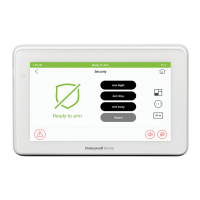6
Security
Introduction to Security System Operation
You can arm the system in one of three arming modes: Away, Stay, and Night. The following table lists the three different arming
modes and the results of each.
FEATURES FOR EACH ARMING MODE
FUNCTION
Select to arm when no one is staying on the
premises. When armed in AWAY, the
system sounds an alarm if a protected door
or window is opened, or if any movement is
detected inside the premises.
Yes Yes Yes Yes
Select to arm when you are staying home,
but might expect someone to use the
entrance door later.
When armed in STAY, the system sounds
an alarm if a protected door or window is
opened, but you may otherwise move freely
throughout the premises.
Yes Yes Yes No
Select to arm when you are staying home
and do not expect anyone to use the
entrance door. Your installer may have
configured NIGHT Mode differently; have
the installer describe the actual settings of
Yes
Yes (set for Away or
Stay Mode)
No (set for Instant or
Maximum Mode)
Yes (set for Away or
Maximum Mode)
No (set for Stay or
Instant Mode)
See Night Mode note below
Note: Night Mode (on Residential Panels Only) arms all perimeter zones plus all zones listed in Zone List 5.
Important: On Commercial systems, “Away Auto Stay” mode is shown as “Away” mode (with all zones monitored). However, some
interior zones may not be armed.
Note: The Voice Status Sounder Icon (
) indicates the Voice feature. Select the Voice Status Sounder Icon to hear system status.
Wait 3 seconds and select again to hear Zone Faults or Trouble conditions. Voice status will annunciate even if Voice mode and Chime
mode are disabled. Note that the Voice feature must be enabled (by the installer) for this icon to function correctly during an alarm
condition.
Note: There is a communicator delay of 30 seconds. This delay will prevent a report to the central station if the control panel is
disarmed within 30 seconds after an intrusion alarm is triggered. This delay can be removed, or it can be increased up to 45 seconds at
the option of the user by consulting with the installer. Note that emergency, carbon monoxide, and fire-type alarms are normally
reported without delay.

